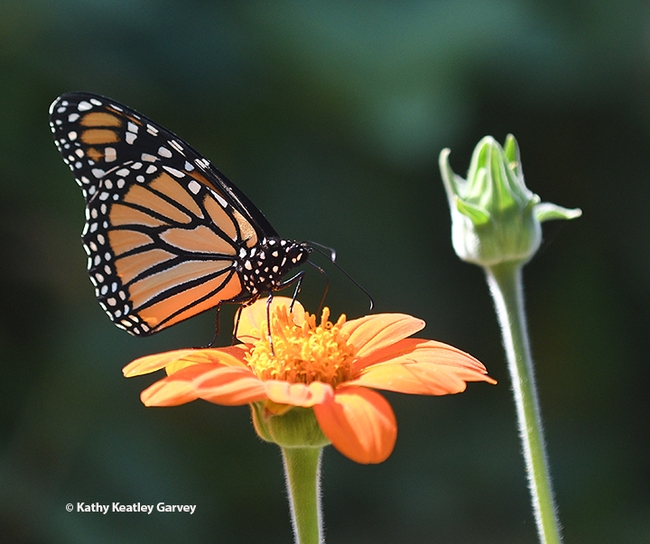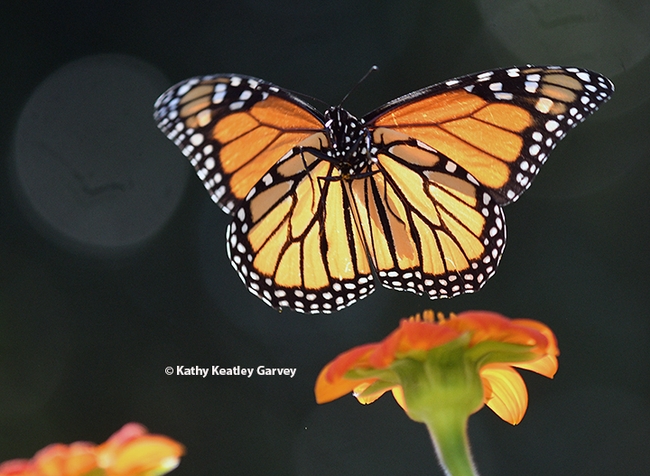
Then you'll want to attend the Bohart Museum of Entomology open house on Saturday, Nov. 4 from 1 to 4 p.m. in Room 1124 of the Academic Surge Building, 455 Crocker Lane. Scientists will be there to answer your questions.
The event is free and family friendly and a great opportunity to learn more about Danaus plexippus.
The scientists will include:
- UC Davis distinguished professor emeritus Art Shapiro of the Department of Evolution and Ecology, who has studied butterfly populations in central California since 1972 and maintains a research website, Art's Butterfly World.
- UC Davis emeritus professor Hugh Dingle, a worldwide authority on animal migration, including monarchs. He is the author of Migration: The Biology of Life on the Move (Oxford University Press), a sequel to the first edition published in 1996. See news story on the UC Davis Entomology and Nematology website.
- UC Davis professor Louie Yang, who does research on monarchs. Due to parental duties, he may be able to attend only the last part of the open house. See news story about his work.
- UC Davis professor Elizabeth Crone of the Department of Evolution and Ecology, formerly of Tufts University, who researches monarchs. See news story about the declining monarch population on the UC Davis Entomology and Nematology website
Shapiro, a Lepidopterist, points out that the monarch "is NOT a focal species in my research and I am NOT a monarch expert. On the other hand, I have a unique breeding-season census data set starting in 1999. The only other census data are for the overwintering roosts on the coast. It has become apparent that the two data sets do not always agree." Shapiro said he'd talk briefly about this at the open house.
"The iconic black and orange monarch butterfly is known for its astonishing long-distance annual migration and reliance on milkweed as its obligate larval host plant," according to a post on the California Department of Fish and Wildlife (CDFW). "Though genetically similar, there are two subpopulations of monarchs in North America, with the eastern population overwintering in Mexico and breeding in the midwestern states, and the western population overwintering in coastal California and fanning out across the west from Arizona to Idaho. Outside the U.S., there are at least 74 known populations of resident, non-migratory monarchs that have established around the world in the past 200 years, all with origins in North America (Nial et al. 2019)."
"Both North American migratory populations have declined over the past twenty years due to a suite of interrelated factors including habitat loss in breeding and overwintering sites, habitat degradation, disease, pesticide exposure, and climate change," CDFW says. "Recently the western population has experienced dramatic swings, for a low of less than 2,000 in 2020-21 to over 200,000 in 2021-22 (Xerces Society Western Monarch Count). While it is unclear which of the many factors are driving these dynamics, insect population commonly fluctuate from year to year. The overall downward trend remains concerning, particularly if the threats are not ameliorated. Though more research is needed, a stable population for western monarchs is likely closer to the historic averages in the 1980's, which are estimated to have ranged between one to four million overwintering butterflies."
"n 2014, monarchs were petitioned to be listed under the federal Endangered Species Act. In December 2020, the U.S. Fish and Wildlife Service found that listing was warranted but precluded by other listing actions on its National Priority List. The monarch is currently slated to be listed in 2024."
The monarch population is in trouble. Says the Xerces Society for Invertebrate Conservation in a post on its website: "In the 1990s, hundreds of millions of monarchs made the epic flight each fall from the northern plains of the U.S. and Canada to sites in the oyamel fir forests in central Mexico, and more than a million monarchs overwintered in forested groves on the California coast. Now, researchers and community scientists estimate that only a fraction of the population remains—a decline of approximately 70% has been seen in central Mexico and a decline of >90% has been seen in California."
Resources/Further Reading:
- Monarch Butterfly, California Department of Fish and Wildlife
- Research Permits, CDFW
- Western Monarch Mllkweed Mapper
- Integrated Monarch Monitoring Program, Monarch Joint Venture
- Western Monarch Count, Xerces Society for Invertebrate Conservation
- Monarch Butterfly Conservation, Xerces Society
- Spreading Milkweed, Not Myths, U.S. Fish and Wildlife Service
- Habitat Corridor Project, Views on milkweed
- Tropical Milkweed Doesn't Deserve the Bad Rap, Bug Squad blog, views on the ban of tropical milkweed by UC Davis emeriti professors Art Shapiro and Hugh Dingle, and Washington State University entomologist David James, who studies migratory monarchs.
Attached Images:

